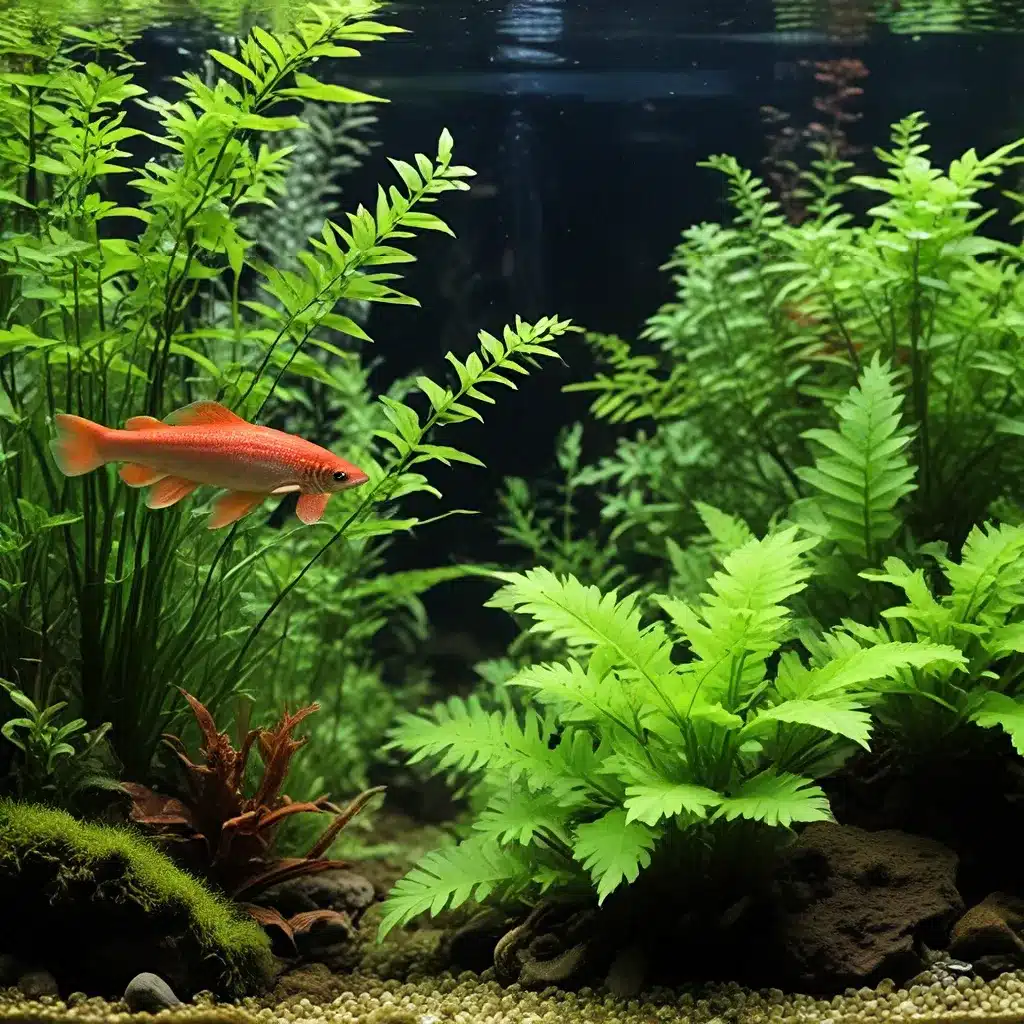
Understanding Plant-Fish Symbiosis
One of the most fascinating aspects of aquarium keeping is the intricate web of relationships that develops between the aquatic plants and the fish inhabitants. This delicate balance, known as plant-fish symbiosis, is a fundamental concept that every aquarist should understand to create a thriving, harmonious aquatic ecosystem.
At the heart of this symbiosis lies the exchange of essential nutrients and oxygen between the plants and fish. The fish, through their natural waste byproducts, provide a constant supply of nutrients, such as nitrates and phosphates, which the plants readily absorb and utilize for growth. In turn, the plants release oxygen into the water, which the fish depend on for their respiratory needs. This mutually beneficial relationship ensures a balanced, self-sustaining aquarium environment.
However, maintaining this equilibrium requires a deeper understanding of the specific care requirements for both the plants and the fish. Careful selection of compatible species, along with diligent water management and aquascaping techniques, are crucial to fostering these beneficial interactions.
Selecting Suitable Plant and Fish Species
When creating a harmonious aquarium ecosystem, the first step is to carefully select plant and fish species that are compatible and complement each other’s needs. Some plants, such as high-light-demanding plants, may thrive in the presence of certain fish species that produce more waste, while others may prefer a more nutrient-rich environment.
Similarly, fish species have varying requirements for water parameters, such as pH, temperature, and hardness. Matching the plant and fish selections to ensure these parameters align is essential for maintaining a stable and thriving aquarium.
To illustrate this point, let’s consider the example of a planted aquarium with Cryptocoryne wendtii (Wendt’s Cryptocoryne) and Betta splendens (Siamese Fighting Fish). Cryptocoryne wendtii is a popular aquarium plant known for its lush, sword-shaped leaves and its ability to thrive in a moderately acidic environment. On the other hand, Betta splendens is a tropical fish that prefers slightly acidic to neutral water conditions.
By carefully selecting these compatible species, the aquarist can create a symbiotic relationship where the Cryptocoryne wendtii benefits from the nutrient-rich environment provided by the Betta’s waste, while the Betta enjoys the oxygenated water produced by the thriving Cryptocoryne plants.
Aquascaping for Optimal Plant-Fish Interactions
Aquascaping, the art of designing and arranging the aquarium’s substrate, hardscape, and plant layouts, plays a crucial role in fostering beneficial plant-fish interactions. By strategically positioning the various elements, aquarists can create an environment that maximizes the efficiency of nutrient cycling and oxygen exchange.
One effective aquascaping technique is the use of planted islands or densely planted areas. These regions act as nutrient sinks, where the plants can actively absorb the waste products released by the fish. This helps to maintain water quality by reducing the buildup of harmful nitrates and phosphates, which can otherwise lead to algae blooms and other water quality issues.
Additionally, the strategic placement of tall, fast-growing plants near the water surface can create oxygenated zones, ensuring that the fish have access to the necessary dissolved oxygen. Conversely, low-growing, carpet-forming plants can be used to provide cover and shelter for the fish, creating a more natural and engaging aquarium environment.
By carefully considering the aquascaping layout, aquarists can optimize the symbiotic relationship between the plants and fish, leading to a thriving, self-sustaining aquarium ecosystem.
Water Management and Monitoring
Maintaining a healthy, balanced aquarium environment is not just about selecting the right plant and fish species – it also requires diligent water management and monitoring. Regular water tests, such as checking for nitrates, phosphates, pH, and dissolved oxygen levels, are crucial to ensure that the aquarium’s water parameters remain within the optimal ranges for both the plants and the fish.
One of the key aspects of water management is nutrient dosing. While the fish’s waste provides a natural source of nutrients for the plants, it may not always be enough to meet the demands of a thriving aquarium. Supplementing with appropriate fertilizers and maintaining a nutrient-rich substrate can help ensure that the plants have access to the essential macro and micronutrients they need to thrive.
Moreover, regular water changes are essential to remove accumulated waste products, replenish fresh water, and maintain stable water parameters. The frequency and volume of water changes should be tailored to the specific needs of the aquarium, taking into account factors such as the plant and fish biomass, lighting intensity, and the presence of any live substrate.
By combining careful species selection, strategic aquascaping, and diligent water management, aquarists can create a harmonious and sustainable aquarium environment that celebrates the symbiotic relationships between aquatic plants and fish.
Achieving a Thriving Aquarium Ecosystem
Fostering beneficial plant-fish interactions is a rewarding and fulfilling aspect of aquarium keeping. By understanding the intricate web of relationships within the aquatic ecosystem, aquarists can create vibrant, self-sustaining environments that not only provide a visually stunning display but also promote the overall health and well-being of the inhabitants.
At King Aquarium, we are passionate about sharing our expertise and guiding aquarists of all skill levels in cultivating thriving aquarium ecosystems. Whether you’re a seasoned enthusiast or a newcomer to the hobby, we encourage you to explore the world of plant-fish symbiosis and discover the joy of maintaining a balanced and harmonious aquarium.
Remember, the key to success lies in a deep understanding of the specific needs of your aquatic plants and fish, as well as a commitment to diligent water management and strategic aquascaping. By fostering these beneficial interactions, you can create a captivating underwater oasis that will inspire and delight you for years to come.

